
As I followed Steve Wartman and his crew through the process of building a deck, many of you sharp-eyed readers noticed that the overhead power lines were very close to the new deck. When I asked Steve about it, he said the power lines were to be buried at a later date. Well that time arrived last week, and here’s how they did it.
Burying power lines is not a very complicated task. However, it can be quite laborious without the right machinery, and a big part of today’s Pro-Follow involves the Ditch Witch. A Ditch Witch is a gas-powered, walk-along trencher used for installing underground service lines, and Steve rented one for the morning.

The chain features tungsten impregnated teeth that will shift most soil types easily.

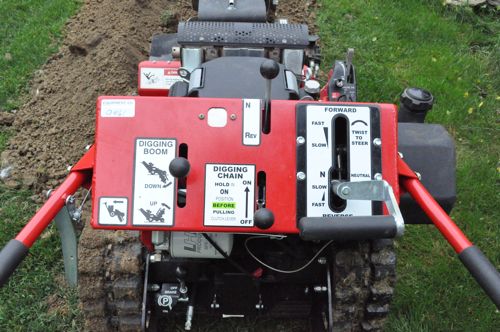
For this job, the guys needed to dig a 120′ trench to bury conduit at 30″ deep (per county requirements). Since Steve already had all underground lines located for the deck job, they did not need to repeat the process.
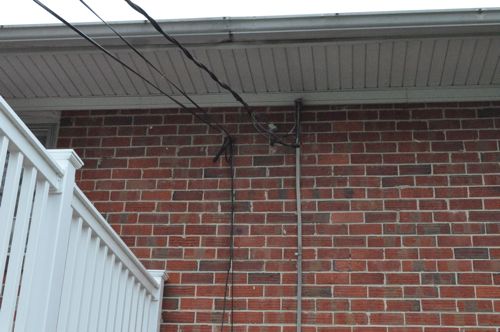
The conduit is 4″ schedule 40 PVC rated for above ground and underground use.

They started by marking the path of the trench underneath the existing wires to the utility pole. Conduit is somewhat flexible, and the line did have a gentle curve to avoid some landscaping.
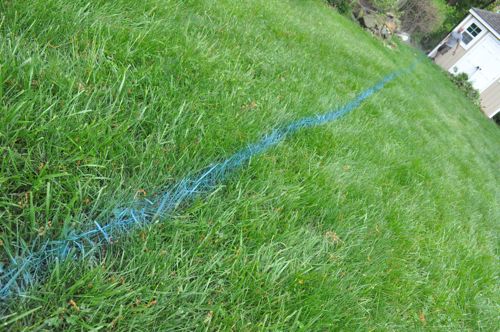
Using the Ditch Witch, they started trenching a path. You can see that the chain cuts through the dirt, roots and even rocks, while a shoot directs dirt to the side.
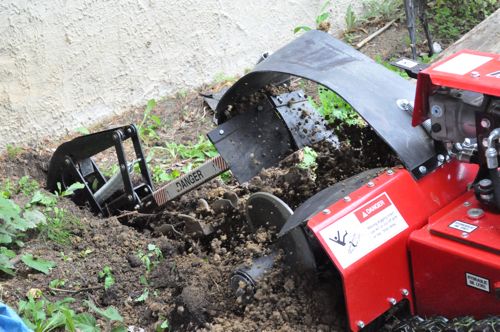


Periodically, they would check to make sure the trench was deep enough.
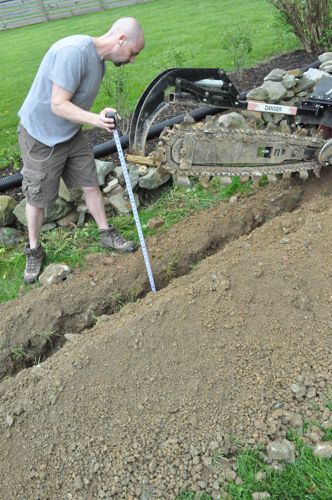
Next to the house and alongside the shed, everything had to be dug by hand. It was slow going, and I can only imagine how difficult this job would be without a Ditch Witch.

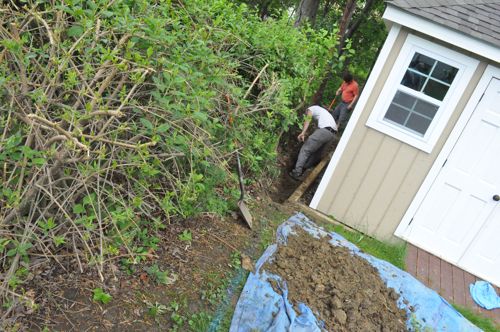
Once the trench was completed, it was time to lay conduit, and all the pieces were glued together with a PVC cement.
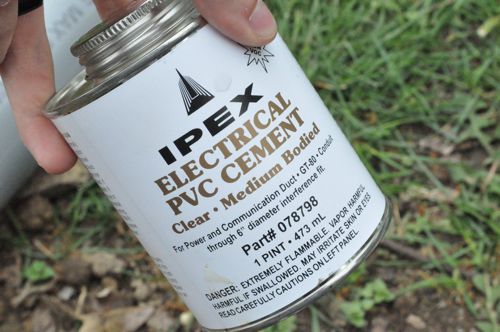

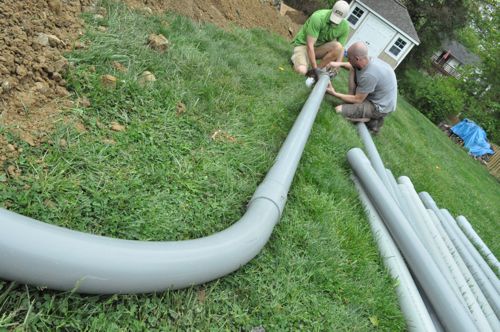
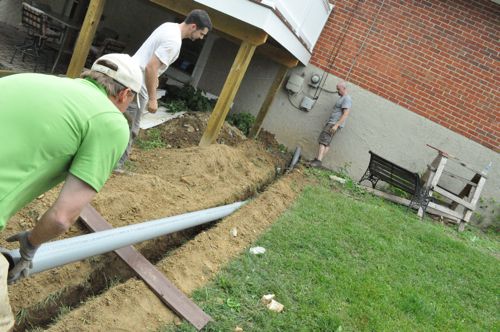
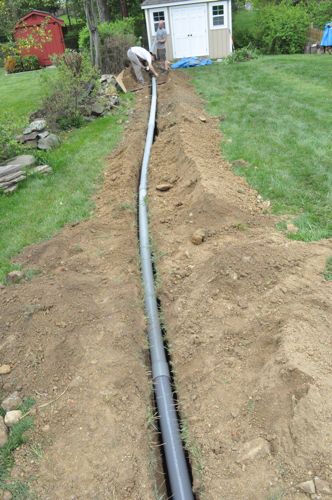
At both ends, they had a 90° elbow that extended a couple of feet above ground level. Steve had a reciprocating saw handy to cut the PVC. It turned out that wasn’t necessary because the conduit was already to perfect length.

After the conduit was in place, they fished a 1/4″ pull rope through.


Tying off a generous length of excess rope, they capped each end with duct tape. BGE, the local utility, will come out and actually run the wires and make the appropriate connections.

I expected that the county would need to inspect the trench before Steve’s crew could fill it. However, that wasn’t the case, and they backfilled the trench.


That’s all for this Pro-Follow. Stay tuned for the next one where I share an update on the bathroom remodel. If you missed it, read about the bathroom demolition at that link.







I’ve never seen a Ditch Witch with a guard over the tip of the chain. Must be a safety device that the rental companies keep, but contractors who own them usually remove.
I just did this on my joint last summer. In my neck of the woods we only have to be 24″ deep but have to be sch 80 above the ground. Sch 40 is just fine in the ground though.
I found that when cutting through roots it’s easier to take a shallow attack angle until the root is cut and then plunge the chain back down.
Very cool! I forgot to ask the guys about pulling permits. Did you pull your own?
how deep is that? I know when my parents buried their electrical it was pretty deep (4 feet maybe), at least to the transformer/meter that is near the house, then it might be a bit shallower (it enters about 2 feet below ground level). buried electrical is always good, one less thing to break in a storm.
They said 30 inches and I’m guessing they stayed pretty close to that. Since this isn’t a drain you don’t need to worry about anything being level and just keep it at the same depth throughout the dig.
Yeah, they stayed at least 30″ deep, especially where they had to cut through rocks.
Stupid question, but does the PVC not need to be (purple-)primed like it does for drain pipes?
Not a stupid question. Now that you bring it up, I’m not sure. Let me circle back to get an answer.
It doesn’t need to be but I don’t know the reason. I didn’t purple mine up either.
Love that name, Ditch-Witch. So am I to understand that they were able to fill in the hole before the Power Lines were inserted into the PVC especially since you have the line running through it?
Yeah the local utility is the only one allowed to re-route the power lines so all contractors can do is run / bury the pipe and give them a line to pull wires.
I was surprised to read that the county or the utility did not need to inspect the conduit and the depth. Ethan, when are you going to get a Ditch Witch for an….umm….tool review?!
I was surprised too. I don’t foresee many ditch witch reviews in my future. You’ll be the first to know if that changes 🙂
How did they fish the pull rope through a 120′ fabricated length of pipe?
Hi Brady,
The electrician used a 250′ fish tape, and they pulled the rope from one end to the other.
They used that ditch witch when my neighbour had their underground sprinkler system redone. Very handy machine.
Back in the 70’s my parents had cable installed for the TV, and the installers used a Ditch Witch to bury it. Unfortunately, they didn’t call before they dug the trench(I was at college, so wasn’t there, and don’t remember if it was even available, let alone a requirement as it is now), but the operator ended up cutting a 200 amp underground line supplying the house. The operator was ok, although seriously shaken, (according to dad he was thrown about 10′ from the machine), but the equipment was totaled, caught fire, the whole enchilada.
I did see the remnants of the equipment, it was a mess, but it reinforced the “call before you dig” rule to me in a way that no public service ad could ever do. 🙂
Wow! While the electrician was working, I double-checked about locating underground lines, and he joked that if that hadn’t been done, he wouldn’t have been operating the ditch witch. You’re story is a good reminder why.
Oh man… that is NUTS, but totally believable, especially if he wasn’t wearing gloves. That would have created a lot of surface area for 220 volts.
Cool post. I’ve never buried cable before, but may have to do something similar here pretty soon.
Did they run both the power and the cable line through the same conduit or is the cable line still strung from the pole?
I don’t think the utility company has been out to reroute the lines yet. However, all of the cables pictured will go through the same conduit.
Thanks for commenting!
We did that on our own a few years back in order to put the garage where we wanted it. Plus there are tons of trees, so buried lines will hopefully save us from any potential branch -induced power outages.
We rented one of those ditch witch things and had quite a time of it. BGE told us 36″ depth so we spent hours late into the night trying to make sure it was that deep all along. We did also have to get a permit. I asked Jeremy why we had to and you guys didn’t and he thinks its because we also got a service upgrade at the same time. Anyhow, after staying up way to late and digging in the dark, I waited for the inspector the next day and he came out and just glanced at it and passed us. I asked him why he didn’t measure it and he said “Oh, you guys are way past 18″, I don’t even need to check.” I was so upset! I wanted him to go measure it just so that I could be validated in all the time we spent. Apparently BGE’s requirements was more than Howard County. Anyhow, after we got the permit we actually used the same trench to run power and phone from the house to the garage. (in different conduit of course.) We also left a pull string in that extra conduit so that we decide we want anything else we can pull that easily. We filled everything in and a few days later BGE came and pulled all the lines!
At the time, it was an extremely frustrating project, but it now it is rather a funny story. :0D
The trench depths noted as 48″ are typical depth for direct burial cable. The 18-30″ depths are for PVC conduit. At one time the NEC allowed 6″ depth for rigid conduit for service feeders to 200 amp in non-traffic installations, with minimu, conduit size 2″. The Commonwealth Edison sales representative about popped a cork when I pointed out to him that his copany’s specifications stated to follow local code for trench depth. We did install the 2″ rigid at 18″ and also pulled the service feeder wires provided by Com Ed. Interestingly, Com Ed provided direct burial cable as the feeder wires. THank goodness for Greenlee cable puller system. That and Ideal wire pulling compound ensured the 100′ pull went in with no troubles.
For what I pay in taxes I would make my Municipality pay for it
Sustained some hearing loss while working with a trencher in the late 70’s. My dad would raise the business end when a rock was hit, and have me dig it out. I’ve asked him to leave me his hearing aids in the will.